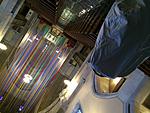I have a situation that I'd like to ask about. I photographed the interior of a nice church today as a warm up for later. I'm going to try to include a snapshot. I used a 65mm lens so it's wide.
There's a pulpit of dark wood. I metered it at something like 3.3 EV. I want detail in some of the walls that have a lamp right by them. The light walls measured around 10.5 EV. There are some good middle values but I'm really wanting to have details on those light, well lit walls on the sides so they aren't blown out. I'm using Ilford FP4+ and I shoot it at ISO125. I didn't record the middle values, but I'm thinking I may want to give n-2 development even though I haven't calculated exactly how much time that will be. I also shot at f45 and my metered exposure was 30 seconds assuming I want to shoot 2 stops brighter than the dark pulpit in order to get detail. I used that nice reciprocity app and it told me I was going to need an exposure of something like 2 and a half minutes, but I'm not sure if that's correct after looking at ilfords own chart.
Any suggestions on development or things to look at in the future? I welcome thread responses as well as inbox messages.




 Reply With Quote
Reply With Quote


Bookmarks